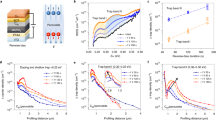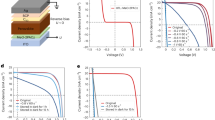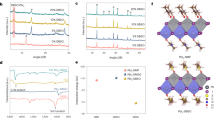Abstract
Stability of perovskite solar cells (PSCs) under light, heat, humidity and their combinations have been notably improved recently. However, PSCs have poor reverse-bias stability that limits their real-world application. Here we report a systematic study on the degradation mechanisms of p–i–n structure PSCs under reverse bias. The oxidation of iodide by injected holes at the cathode side initialize the reverse-bias-induced degradation, then the generated neutral iodine oxidizes metal electrode such as copper, followed by drift of Cu+ into perovskites and its reduction by injected electrons, resulting in localized metallic filaments and thus device breakdown. A reinforced barrier with combined lithium fluoride, tin oxide and indium tin oxide at the cathode side reduces device dark current and avoids the corrosion of Cu0. It dramatically increases breakdown voltage to above −20 V and improved the T90 lifetime of PSCs to ~1,000 h under –1.6 V. The modified minimodule also maintained over 90% of its initial performance after 720 h of shadow tests.
This is a preview of subscription content, access via your institution
Access options
Access Nature and 54 other Nature Portfolio journals
Get Nature+, our best-value online-access subscription
27,99 € / 30 days
cancel any time
Subscribe to this journal
Receive 12 digital issues and online access to articles
118,99 € per year
only 9,92 € per issue
Buy this article
- Purchase on SpringerLink
- Instant access to full article PDF
Prices may be subject to local taxes which are calculated during checkout





Similar content being viewed by others
Data availability
All data generated or analysed during this study are included in the published article and its supplementary information. Source data are provided with this paper.
References
Green, M. A. et al. Solar cell efficiency tables (version 62). Prog. Photovoltaics Res. Appl. 31, 651–663 (2023).
Li, C. et al. Rational design of Lewis base molecules for stable and efficient inverted perovskite solar cells. Science 379, 690–694 (2023).
Park, S. M. et al. Engineering ligand reactivity enables high-temperature operation of stable perovskite solar cells. Science 381, 209–215 (2023).
Wang, T. et al. Transporting holes stably under iodide invasion in efficient perovskite solar cells. Science 377, 1227–1232 (2022).
Bai, S. et al. Planar perovskite solar cells with long-term stability using ionic liquid additives. Nature 571, 245–250 (2019).
Fei, C. et al. Lead-chelating hole-transport layers for efficient and stable perovskite minimodules. Science 380, 823–829 (2023).
Gu, H. et al. Design optimization of bifacial perovskite minimodules for improved efficiency and stability. Nat. Energy 8, 675–684 (2023).
Deng, Y. et al. Defect compensation in formamidinium–caesium perovskites for highly efficient solar mini-modules with improved photostability. Nat. Energy 6, 633–641 (2021).
Wang, Z. et al. Suppressed phase segregation for triple-junction perovskite solar cells. Nature 618, 74–79 (2023).
Shi, L. et al. Gas chromatography–mass spectrometry analyses of encapsulated stable perovskite solar cells. Science 368, eaba2412 (2020).
Li, N., Niu, X., Chen, Q. & Zhou, H. Towards commercialization: the operational stability of perovskite solar cells. Chem. Soc. Rev. 49, 8235–8286 (2020).
Wang, C. et al. Perovskite solar cells in the shadow: understanding the mechanism of reverse-bias behavior toward suppressed reverse-bias breakdown and reverse-bias induced degradation. Adv. Energy Mater. 13, 2203596 (2023).
Lan, D. & Green, M. A. Combatting temperature and reverse-bias challenges facing perovskite solar cells. Joule 6, 1782–1797 (2022).
Bogachuk, D. et al. Perovskite photovoltaic devices with carbon-based electrodes withstanding reverse-bias voltages up to –9 V and surpassing IEC 61215:2016 international standard. Sol. RRL 6, 2100527 (2022).
Bertoluzzi, L. et al. Incorporating electrochemical halide oxidation into drift-diffusion models to explain performance losses in perovskite solar cells under prolonged reverse bias. Adv. Energy Mater. 11, 2002614 (2021).
Ni, Z. et al. Evolution of defects during the degradation of metal halide perovskite solar cells under reverse bias and illumination. Nat. Energy 7, 65–73 (2022).
Xu, Z. et al. Reverse-bias resilience of monolithic perovskite/silicon tandem solar cells. Joule 7, 1992–2002 (2023).
Wolf, E. J., Gould, I. E., Bliss, L. B., Berry, J. J. & McGehee, M. D. Designing modules to prevent reverse bias degradation in perovskite solar cells when partial shading occurs. Sol. RRL 6, 2100239 (2022).
Kim, D. et al. Light- and bias-induced structural variations in metal halide perovskites. Nat. Commun. 10, 444 (2019).
Jeangros, Q. et al. In situ TEM analysis of organic–inorganic metal-halide perovskite solar cells under electrical bias. Nano Lett. 16, 7013–7018 (2016).
Rajagopal, A., Williams, S. T., Chueh, C.-C. & Jen, A. K. Y. Abnormal current–voltage hysteresis induced by reverse bias in organic–inorganic hybrid perovskite photovoltaics. J. Phys. Chem. Lett. 7, 995–1003 (2016).
Jia, S. et al. Ion-accumulation-induced charge tunneling for high gain factor in p–i–n-structured perovskite CH3NH3PbI3 X-ray detector. Adv. Mater. Technol. 7, 2100908 (2022).
Li, W. et al. Sparkling hot spots in perovskite solar cells under reverse bias. ChemPhysMater 1, 71–76 (2022).
Xu, Z., Kerner, R. A., Berry, J. J. & Rand, B. P. Iodine electrochemistry dictates voltage-induced halide segregation thresholds in mixed-halide perovskite devices. Adv. Funct. Mater. 32, 2203432 (2022).
Kerner, R. A., Xu, Z., Larson, B. W. & Rand, B. P. The role of halide oxidation in perovskite halide phase separation. Joule 5, 2273–2295 (2021).
Xiao, Z. et al. Giant switchable photovoltaic effect in organometal trihalide perovskite devices. Nat. Mater. 14, 193–198 (2015).
Leijtens, T. et al. Mapping electric field-induced switchable poling and structural degradation in hybrid lead halide perovskite thin films. Adv. Energy Mater. 5, 1500962 (2015).
Bowring, A. R., Bertoluzzi, L., O’Regan, B. C. & McGehee, M. D. Reverse bias behavior of halide perovskite solar cells. Adv. Energy Mater. 8, 1702365 (2018).
Razera, R. A. Z. et al. Instability of p–i–n perovskite solar cells under reverse bias. J. Mater. Chem. A 8, 242–250 (2020).
Najafi, L. et al. Reverse-bias and temperature behaviors of perovskite solar cells at extended voltage range. ACS Appl. Energy Mater. 5, 1378–1384 (2022).
Xu, Z. et al. Halogen redox shuttle explains voltage-induced halide redistribution in mixed-halide perovskite devices. ACS Energy Lett. 8, 513–520 (2023).
Zhao, Z. et al. Crystal size effect on carrier transport of microscale perovskite junctions via soft contact. Nano Lett. 20, 8640–8646 (2020).
Ma, Y. et al. Suppressing ion migration across perovskite grain boundaries by polymer additives. Adv. Funct. Mater. 31, 2006802 (2021).
Moehl, T. et al. Strong photocurrent amplification in perovskite solar cells with a porous TiO2 blocking layer under reverse bias. J. Phys. Chem. Lett. 5, 3931–3936 (2014).
Ren, X. et al. Mobile iodides capture for highly photolysis- and reverse-bias-stable perovskite solar cells. Nat. Mater. https://doi.org/10.1038/s41563-024-01876-2 (2024).
Bratsch, S. G. Standard electrode potentials and temperature coefficients in water at 298.15 K. J. Phys. Chem. Ref. Data 18, 1–21 (1989).
Wang, Y., Teo, H. W., Ong, K. K., Mo, Z. Q. & Zhao, S. P. Study on copper diffusion barrier materials by Time-of-Flight Secondary Ion Mass Spectrometry (ToF-SIMS). In Proc. 2016 IEEE 23rd International Symposium on the Physical and Failure Analysis of Integrated Circuits (IPFA) 140–143 (IEEE, 2016).
Chen, S. et al. Stabilizing perovskite–substrate interfaces for high-performance perovskite modules. Science 373, 902–907 (2021).
Zhao, J. et al. Is Cu a stable electrode material in hybrid perovskite solar cells for a 30-year lifetime? Energy Environ. Sci. 9, 3650–3656 (2016).
Chen, S., Xiao, X., Gu, H. & Huang, J. Iodine reduction for reproducible and high-performance perovskite solar cells and modules. Sci. Adv. 7, eabe8130 (2021).
Ni, Z. et al. High grain boundary recombination velocity in polycrystalline metal halide perovskites. Sci. Adv. 8, eabq8345 (2022).
Mastroianni, S., Lembo, A., Brown, T. M., Reale, A. & Di Carlo, A. Electrochemistry in reverse biased dye solar cells and dye/electrolyte degradation mechanisms. ChemPhysChem 13, 2964–2975 (2012).
Bush, K. A. et al. 23.6%-efficient monolithic perovskite/silicon tandem solar cells with improved stability. Nat. Energy 2, 17009 (2017).
Xu, J. et al. Triple-halide wide–band gap perovskites with suppressed phase segregation for efficient tandems. Science 367, 1097–1104 (2020).
Palmstrom, A. F. et al. Interfacial effects of tin oxide atomic layer deposition in metal halide perovskite photovoltaics. Adv. Energy Mater. 8, 1800591 (2018).
Xiao, K. et al. Scalable processing for realizing 21.7%-efficient all-perovskite tandem solar modules. Science 376, 762–767 (2022).
Chin, X. Y. et al. Interface passivation for 31.25%-efficient perovskite/silicon tandem solar cells. Science 381, 59–63 (2023).
Mariotti, S. et al. Interface engineering for high-performance, triple-halide perovskite–silicon tandem solar cells. Science 381, 63–69 (2023).
Aydin, E. et al. Enhanced optoelectronic coupling for perovskite/silicon tandem solar cells. Nature 623, 732–738 (2023).
Correa Baena, J. P. et al. Highly efficient planar perovskite solar cells through band alignment engineering. Energy Environ. Sci. 8, 2928–2934 (2015).
Liu, J. et al. Efficient and stable perovskite-silicon tandem solar cells through contact displacement by MgFx. Science 377, 302–306 (2022).
Li, N. et al. Cation and anion immobilization through chemical bonding enhancement with fluorides for stable halide perovskite solar cells. Nat. Energy 4, 408–415 (2019).
Seo, J. et al. Benefits of very thin PCBM and LiF layers for solution-processed p–i–n perovskite solar cells. Energy Environ. Sci. 7, 2642–2646 (2014).
Al-Ashouri, A. et al. Monolithic perovskite/silicon tandem solar cell with >29% efficiency by enhanced hole extraction. Science 370, 1300–1309 (2020).
You, M. et al. Improving efficiency and stability in quasi-2D perovskite light-emitting diodes by a multifunctional LiF interlayer. ACS Appl. Mater. Interfaces 12, 43018–43023 (2020).
Peña-Camargo, F. et al. Halide segregation versus interfacial recombination in bromide-rich wide-gap perovskite solar cells. ACS Energy Lett. 5, 2728–2736 (2020).
Stolterfoht, M. et al. Visualization and suppression of interfacial recombination for high-efficiency large-area pin perovskite solar cells. Nat. Energy 3, 847–854 (2018).
Menzel, D. et al. Field effect passivation in perovskite solar cells by a LiF interlayer. Adv. Energy Mater. 12, 2201109 (2022).
Khenkin, M. V. et al. Consensus statement for stability assessment and reporting for perovskite photovoltaics based on ISOS procedures. Nat. Energy 5, 35–49 (2020).
Dai, X. et al. Pathways to high efficiency perovskite monolithic solar modules. PRX Energy 1, 013004 (2022).
Chen, B. et al. Grain engineering for perovskite/silicon monolithic tandem solar cells with efficiency of 25.4%. Joule 3, 177–190 (2019).
Harvey, S. P., Messinger, J., Zhu, K., Luther, J. M. & Berry, J. J. Investigating the effects of chemical gradients on performance and reliability within perovskite solar cells with TOF-SIMS. Adv. Energy Mater. 10, 1903674 (2020).
Acknowledgements
This material is based upon work supported by the US Department of Energy’s Office of Energy Efficiency and Renewable Energy (EERE) under Solar Energy Technologies Office award number DE-EE0009520. This work was authored in part by the National Renewable Energy Laboratory, operated by Alliance for Sustainable Energy, LLC, for the US Department of Energy (DOE) under contract number DE-AC36-08GO28308. The views expressed in the article do not necessarily represent the views of the DOE or the US Government.
Author information
Authors and Affiliations
Contributions
N.L. and J.H. conceived the idea. N.L. fabricated and characterized perovskite films and devices. Z.S. performed the PL mapping and NMR measurements. C.F. and H.G. optimized the device fabrication and laser scribing process. H.J. carried out device encapsulation and performed PL mapping measurements. M.L. conducted XRD measurements. S.P.H, Y.D. and M.C.B. conducted TOF-SIMS measurements. N.L. and J.H. wrote the paper and all authors commented on the paper.
Corresponding author
Ethics declarations
Competing interests
The authors declare the following competing interests: Tandem PV has a license for the following technologies used or evaluated in this paper: an ink formulation for fast coating of perovskites and BHC for reducing iodine. J.H. is an inventor of the technologies and has or could receive royalties. These relationships have been disclosed to and are under management by UNC-Chapel Hill.
Peer review
Peer review information
Nature Energy thanks Andreas Hinsch, Anton Ievlev and the other, anonymous, reviewer(s) for their contribution to the peer review of this work.
Additional information
Publisher’s note Springer Nature remains neutral with regard to jurisdictional claims in published maps and institutional affiliations.
Supplementary information
Supplementary Information
Supplementary Notes 1–3, Figs. 1–25 and Tables 1–14.
Supplementary Data 1
13a, 13b, 13c.
Supplementary Data 2
14a, 14b, 14c.
Supplementary Data 4
16a, 16b.
Supplementary Data 5
17a, 17b, 17c, 17d.
Supplementary Data 6
18a, 18b.
Supplementary Data 7
19a, 19b, 19c.
Supplementary Data 8
20a, 20b.
Source data
Source Data Fig. 3
Statistical source data.
Source Data Fig. 4
Statistical source data.
Source Data Fig. 5
Statistical source data.
Rights and permissions
Springer Nature or its licensor (e.g. a society or other partner) holds exclusive rights to this article under a publishing agreement with the author(s) or other rightsholder(s); author self-archiving of the accepted manuscript version of this article is solely governed by the terms of such publishing agreement and applicable law.
About this article
Cite this article
Li, N., Shi, Z., Fei, C. et al. Barrier reinforcement for enhanced perovskite solar cell stability under reverse bias. Nat Energy 9, 1264–1274 (2024). https://doi.org/10.1038/s41560-024-01579-7
Received:
Accepted:
Published:
Issue Date:
DOI: https://doi.org/10.1038/s41560-024-01579-7
This article is cited by
-
Retrospective on research in 2024
Nature Energy (2025)
-
Cost Effectivities Analysis of Perovskite Solar Cells: Will it Outperform Crystalline Silicon Ones?
Nano-Micro Letters (2025)
-
Raising the bar for breakdown
Nature Energy (2024)



